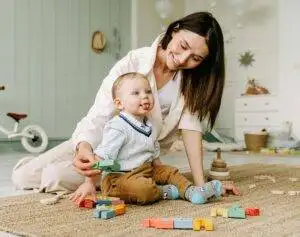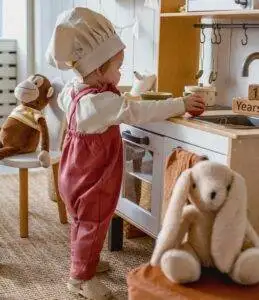What Is Play-Based Therapy? 🎲
Play-based therapy is a type of therapy where children learn through engaging in games and fun activities. Instead of drills or exercises, they use toys, games, and make-believe. This therapy helps tiny hands and big muscles and even helps them learn to move more smoothly.
It’s fun and feels like play—so kids don’t even realize they’re learning!
Why It Works for Motor Delay
Builds Skills Naturally
Kids play first, learn next. Picking up blocks, running, or tossing a ball helps build strength, coordination, and balance—all while having a blast!
Makes Therapy Fun
Most kids don’t like repetitive exercises, but they love playing. When therapy is fun, they are more likely to participate. This helps them practice more and faster.
Helps Brain Connections
Play-based activities light up the brain. They create new neural (nerve) pathways that help with motor planning (thinking about how to move) and muscle control.

Types of Play for Different Motor Delays
Gross Motor Skills (Big Movements)
- Obstacle Courses: Jumping, crawling, hopping. Helps strength and balance.
- Ball Games: Kick a ball back and forth or roll it. Helps leg and arm coordination.
- Animal Walks: Crawl like a bear or hop like a frog—great for whole-body movement.
Fine Motor Skills (Little Hands)
- Playdough: Squishing, rolling, and cutting with rollers or kid scissors.
- Beading/Super Simple Jewelry: Threading big beads on strings helps finger strength.
- Sticker Collage: Peeling and placing small stickers is great for hand usage.
Bilateral Coordination (Using Both Sides Together)
- Clap-and-Catch: Clap hands, then catch a ball with both hands.
- Tug-of-War with Soft Toy: Helps arms work together to pull the toy gently.
- Building Blocks: One hand stabilizes while the other stacks blocks—teamwork in action!
Getting Started with Play-Based Therapy
Step 1 – Know Your Child’s Goals
Talk with a physical therapist or occupational therapist to figure out what your child needs. Goals might be walking steadily, picking up small things, or balancing.
Step 2 – Choose Fun Activities
Pick a play based on goals. If your child needs leg strength, make a fun hopscotch board. Want better hand skills? Use squishy toys and playdough.
Step 3 – Make a Plan
Set a simple routine: “Play first, bounce ball next, then cool-down puzzle.” Keep each activity short—5 to 10 minutes. Four times a week is a strong schedule.
Step 4 – Keep It Light
Encourage your child with a smile. Praise even small successes: “Great jump!” or “Fantastic catch!” It builds confidence and helps them keep going.
Sample Weekly Plan for Motor Delay
Here’s a simple week plan to follow. Adjust as needed!
| Day | Activity 1 | Activity 2 | Cool‑Down Activity |
| Monday | Obstacle course (gross motor) | Playdough fun (fine motor) | Read a story with actions |
| Tuesday | Throw & catch ball game | Beading bracelets | Sticker collage drawing |
| Wednesday | Animal walks in the living room | Stacking blocks | Coloring page |
| Thursday | Hopscotch with chalk or tape | Tweezers + pom-pom sorting | Listening to fun songs |
| Friday | Soft tug-of-war toy | Playdough cutting | Family puzzle time |
Progress Tracking Tips
- Photo/Video Diary: Snap short clips each week and see how your child is improving.
- Milestones Jar: Celebrate big steps (first crawl, standing unassisted) by writing them on paper and adding them to a jar—fun to look back on!
- Therapist Check-Ins: Review your child’s progress monthly with a therapist. They can suggest new games and challenges.
When to See a Therapist or Doctor
It’s best to speak with a professional if your child:
- Isn’t meeting gross motor milestones by 12 months (like crawling or walking).
- Has trouble holding small toys or snacks by 18 months.
- Seems to be in pain when moving muscles or joints.
- Has a sudden drop in movement skills.
Therapists can give a full evaluation and a customized plan.
Top 5 Essential Play Tools for Home
- Playdough or modeling clay—promotes hand strength and finger coordination.
- Soft balls of various sizes—best for throwing, catching, and kicking.
- Blocks or stacking toys—great for balance and bilateral hand use.
- Tape/chalk for floor games—hopscotch, zig-zag movements.
- Large beads and strings—improve fine motor precision and patience.
These inexpensive tools help build a home therapy plan that’s both fun and effective.
At-Home Tips from Therapists
Rotate Toys Weekly
Introduce 2–3 new toys each week. This keeps play fresh and challenges different skills.
Make Daily Life a Game
Turn chores into play:
- Ask your child to bring three socks for fine motor practice.
- Have them hop to pick up toys for balance.
Sibling or Friend Play
Let siblings or friends join in. This encourages social play, imitation, and natural movement. They model skills while playing together!
Parent Voice: Success Story
“Our son, Leo, was 18 months old and not walking well. We tried play-based therapy: ball play, toy tunnels, and stacking cups. In two months, he walked—and he beams with pride! He never thought of it as therapy—just fun.”
Real stories like Leo’s show how small, consistent play can lead to huge progress.
Understanding the Science Behind Play-Based Therapy
- Neuroplasticity—the brain’s ability to change. Fun, repetitive play encourages new brain pathways.
- Motor Learning Theory—Skills improve through repetition in real-life tasks.
- Motivation Theory—Kids are more likely to repeat fun things, leading to more practice and improvement.
Frequently Asked Questions
Q1: How much time should my child spend on play-based therapy daily?
A: Just 10–20 minutes a day—but do it regularly (4–5 times a week). Consistency over quantity matters most.
Q2: My child resists therapy. What can I try?
A: Try different games or adjust the difficulty. Pair therapy time with a favorite toy. Praise warmly for each try.
Q3: Can I combine regular therapy with play-based therapy at home?
A: Absolutely! Let therapists guide the main goals, then reinforce at home with games based on those goals.
Engage Your Little One in Play-Based Therapy; It Works Wonders

- Engaging: Kids think it’s play, not work.
- Effective: Builds physical and brain skills together.
- Empowering: Kids see themselves getting stronger and more confident.
By using simple tools, fun games, and a joyful attitude, you can support your child’s motor development every day. This complete guide gives you the pathway, resources, and confidence to make movement fun—and effective!
🚀 Ready to start play-based therapy today?
Pick just one new game, set a consistent time, and celebrate small wins. You’ve got this!
Resources and Further Reading
For evidence-backed guidance and ideas, check out Omega Pediatrics blogs:
📌Unlocking the Benefits of Imaginative Play for Children’s Creativity & Social Skills
📌The Benefits of Arts and Crafts for Kids: Unlocking Creative Thinking and Fine Motor Skills
These two posts offer more games and milestone guides to support your journey.



